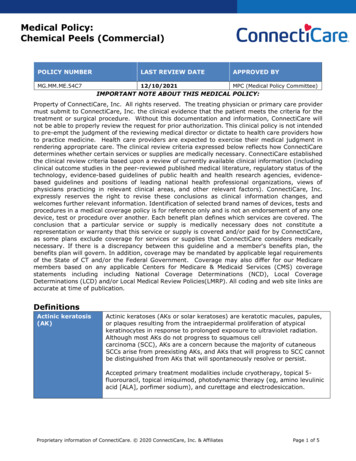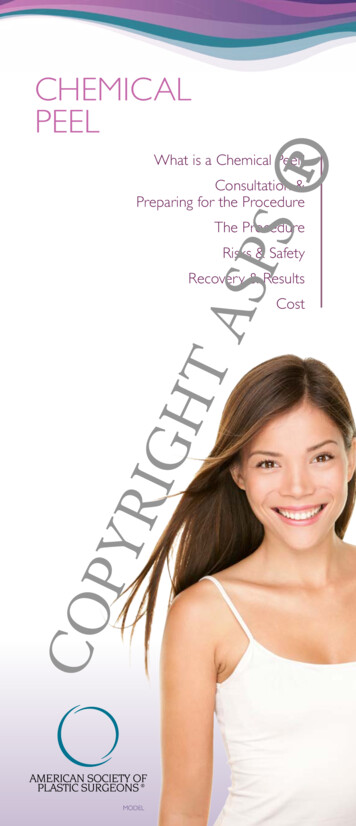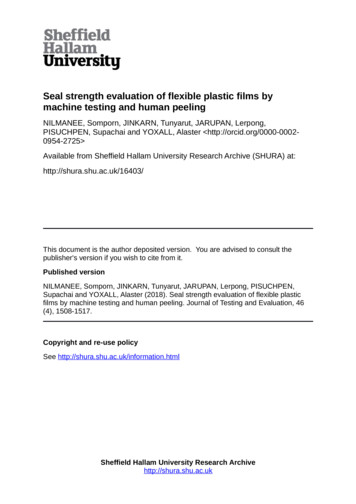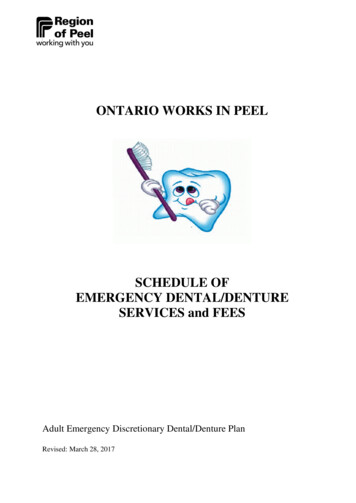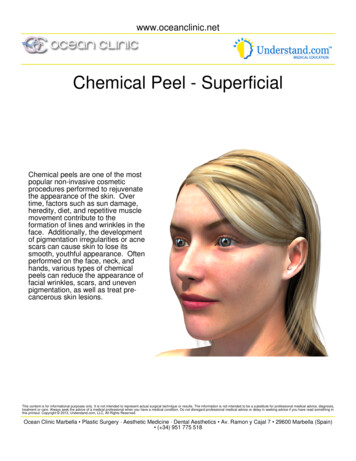
Transcription
www.oceanclinic.netChemical Peel - SuperficialChemical peels are one of the mostpopular non-invasive cosmeticprocedures performed to rejuvenatethe appearance of the skin. Overtime, factors such as sun damage,heredity, diet, and repetitive musclemovement contribute to theformation of lines and wrinkles in theface. Additionally, the developmentof pigmentation irregularities or acnescars can cause skin to lose itssmooth, youthful appearance. Oftenperformed on the face, neck, andhands, various types of chemicalpeels can reduce the appearance offacial wrinkles, scars, and unevenpigmentation, as well as treat precancerous skin lesions.This content is for informational purposes only. It is not intended to represent actual surgical technique or results. The information is not intended to be a substitute for professional medical advice, diagnosis,treatment or care. Always seek the advice of a medical professional when you have a medical condition. Do not disregard professional medical advice or delay in seeking advice if you have read something inthis printout. Copyright 2013, Understand.com, LLC, All Rights Reserved.Ocean Clinic Marbella Plastic Surgery · Aesthetic Medicine · Dental Aesthetics Av. Ramon y Cajal 7 29600 Marbella (Spain) ( 34) 951 775 518
www.oceanclinic.netSuperficial Peel IntroductionChemical peels are one of the most popular non-invasive cosmeticprocedures performed to rejuvenate the appearance of the skin.Over time, factors such as sun damage, heredity, diet, andrepetitive muscle movement contribute to the formation of linesand wrinkles in the face. Additionally, the development ofpigmentation irregularities or acne scars can cause skin to lose itssmooth, youthful appearance. Often performed on the face, neck,and hands, various types of chemical peels can reduce theappearance of facial wrinkles, scars, and uneven pigmentation, aswell as treat pre-cancerous skin lesions.Superficial PeelsSuperficial peels are the mildest form of chemical peel treatment.Superficial peels are usually performed using alphahydroxy acids,and in some instances betahydroxy acids. Alphahydroxy acids arenaturally occurring acids which include glycolic acid, lactic acid,and fruit acids, while betahydroxy acids include salicylic acid. Youmay be familiar with glycolic acid and salicylic acid, as they areoften key ingredients in facial creams and astringents. Althoughthe concentration of acid may vary depending on the extent oftreatment, the acids used to perform superficial peels are not asharsh as other chemical peels. In fact, low concentrations ofalphahydroxy acids are often mixed with facial creams or washesthat can be used as part of a daily facial care routine to maintain ayouthful appearance. With little downtime, superficial peels are asafe, effective method of treating fine lines, pigmentationabnormalities, acne scars, and persistent dry skin.This content is for informational purposes only. It is not intended to represent actual surgical technique or results. The information is not intended to be a substitute for professional medical advice, diagnosis,treatment or care. Always seek the advice of a medical professional when you have a medical condition. Do not disregard professional medical advice or delay in seeking advice if you have read something inthis printout. Copyright 2013, Understand.com, LLC, All Rights Reserved.Ocean Clinic Marbella Plastic Surgery · Aesthetic Medicine · Dental Aesthetics Av. Ramon y Cajal 7 29600 Marbella (Spain) ( 34) 951 775 518
www.oceanclinic.netSkin Damage and Wrinkle FormationThe skin is composed of two layers know as the epidermis anddermis. The epidermis, or outer layer of the skin, acts as the skin'sprimary defense against the environment. As a result, these layersare damaged. The dermis, or innermost layer of the skin, iscomposed primarily of connective tissue. Within the connectivetissue of the dermis, collagen and elastin fibers form a network thatprovides the skin with structure, support, and elasticity. Over time,this network of fibers breaks down as well, which in addition toother factors, further contributes to the formation of wrinkles andother changes in appearance.How Do Superficial Peels Work?During a superficial peel, a chemical solution is applied to the face.The solution causes mild trauma, or injury, to the epidermis, whichis composed of five distinct layers. Similar to exfoliating your skin,the injury causes the damaged outer layers of the epidermis topeel away. As part of the healing process, increased cell growthproduces new, healthier skin layers beneath, which give the face amore youthful, rejuvenated appearance.It is important to realize that superficial peels are not intended totreat deep wrinkles or significantly sagging skin. In thesecircumstances, a face lift or dermal filler injections may producemore desirable results.This content is for informational purposes only. It is not intended to represent actual surgical technique or results. The information is not intended to be a substitute for professional medical advice, diagnosis,treatment or care. Always seek the advice of a medical professional when you have a medical condition. Do not disregard professional medical advice or delay in seeking advice if you have read something inthis printout. Copyright 2013, Understand.com, LLC, All Rights Reserved.Ocean Clinic Marbella Plastic Surgery · Aesthetic Medicine · Dental Aesthetics Av. Ramon y Cajal 7 29600 Marbella (Spain) ( 34) 951 775 518
www.oceanclinic.netProcedure PreparationOften referred to as the "lunchtime peel," superficial peelsgenerally last between fifteen and thirty minutes. A few weeksbefore your procedure, your physician may recommend that youuse a facial product that contains trans retinoic acid. This isbecause trans retinoic acid is believed to prepare the outer layer ofskin for treatment as well as allow the chemical peel solution tosoak evenly through your skin. You may also be required to washyour face with a special soap twenty-four hours before yourprocedure. Prior to the start of your procedure, the treatment areaswill be cleansed. While you may feel a slight stinging or warmingsensation during the procedure, you will most likely not feel anysignificant pain. Therefore, an anesthetic is usually not necessaryfor a superficial peel.Superficial Peel ProcedureUsing a sponge or a brush, the physician will apply the chemicalsolution to individual areas over the entire face. The solution willpenetrate into your skin for approximately fifteen minutes and thenit will be removed or neutralized with a different substance.Superficial peels generally treat the epidermis, which is why theeffects of treatment are less than other types of chemical peels.The chemical solution used during a superficial peel damages theoutermost layers of the epidermis, which causes them to peelaway. The healing process triggers cell growth which generatesnew skin layers. In addition, the healing process also stimulatescollagen and elastin production in the dermis. As the damagedskin peels away, the new skin is revealed, giving the face asmoother, revitalized, more youthful appearance.This content is for informational purposes only. It is not intended to represent actual surgical technique or results. The information is not intended to be a substitute for professional medical advice, diagnosis,treatment or care. Always seek the advice of a medical professional when you have a medical condition. Do not disregard professional medical advice or delay in seeking advice if you have read something inthis printout. Copyright 2013, Understand.com, LLC, All Rights Reserved.Ocean Clinic Marbella Plastic Surgery · Aesthetic Medicine · Dental Aesthetics Av. Ramon y Cajal 7 29600 Marbella (Spain) ( 34) 951 775 518
www.oceanclinic.netSuperficial Peel RecoveryImmediately following your procedure, you may experience someredness and irritation that is similar to sunburn. As healing takesplace, you may also notice some crusting or flaking of your skin.These symptoms will most likely subside in approximately sevendays. Although bandaging is not necessary, like any wound it isimportant to keep the area moist and protected. Therefore, yourphysician may recommend that you apply a protective ointment toyour face in the days following your procedure. You will most likelynotice the outer layers of the skin peeling away within several daysfollowing treatment. New skin will begin to appear in approximatelyone to two weeks. Your skin will be more sensitive to sun exposureas it heals. Therefore, it is extremely important that you protectyour skin from the sun with UVA and UVB protection while youheal.Superficial Peel ResultsThe results from a superficial peel are generally mild compared tomore aggressive forms of treatment such as a medium or deeppeel. However, this also means that the risks associated with theprocedure are typically less. Your physician may recommend thatyou undergo repeated treatments at regular intervals. Forexample, some individuals receive treatments on a weekly ormonthly basis until the desired result is achieved.It is important to realize that the appearance of your skin willcontinue to change and age after you have had a superficial peeltreatment. However, superficial peels are a fast, effective methodof rejuvenating your skin.This content is for informational purposes only. It is not intended to represent actual surgical technique or results. The information is not intended to be a substitute for professional medical advice, diagnosis,treatment or care. Always seek the advice of a medical professional when you have a medical condition. Do not disregard professional medical advice or delay in seeking advice if you have read something inthis printout. Copyright 2013, Understand.com, LLC, All Rights Reserved.Ocean Clinic Marbella Plastic Surgery · Aesthetic Medicine · Dental Aesthetics Av. Ramon y Cajal 7 29600 Marbella (Spain) ( 34) 951 775 518
Procedure Preparation Often referred to as the "lunchtime peel," superficial peels generally last between fifteen and thirty minutes. A few weeks before your procedure, your physician may recommend that you use a facial product that contains trans retinoic acid. This is because trans retinoic acid is believed to prepare the outer layer of
